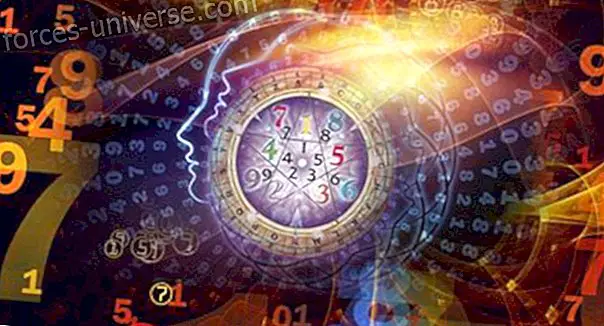
Since ancient times, cats, one of the most popular pets in the world today, have been associated with the world of night, death and paranormal and inexplicable facts. And it is that their nature has always been overshadowed by a mists of mystery, the same that has led to that in different cultures, both in the ancient and modern world, it is believed that these haughty, independent and agile felines are carriers of perceptual abilities extraordinary ones that human beings lack.
Egyptian civilization, the most esoteric of ancient cultures, felt a reverential respect for cats. Domesticated around 2, 800 BC, due to their great ability to keep temples and rodent-free homes, these felines were divinized into one of the most well-known deities of Pharaonic Egypt, the goddess Bastet, who was depicted with a cat's head and had a city of its own, Bubastis, located in the Nile Delta. Among the attributes of the goddess cat was being a guardian of homes, defender of children and representative of maternal sweetness and abundance. The ancient Egyptians felt such devotion to these felines that, if there was a fire, the first thing to be safe was the house cats. And when one of them died, the family dedicated a special duel, as if it were a beloved relative (the Greek historian Herodotus says that the inhabitants of the family, mainly the head of the family, shaved their eyebrows as a sign of mourning, before the animal was mummified and buried).
The Phoenician merchants would have been those who introduced the first domestic cats to Europe, although others claim that they were the ancient Greeks, who assimilated the Egyptian goddess Bastet to their deity Artemis. The Celts, another people fond of the hidden world, believed that the mysterious eyes of these cats were the door that led to the world of small creatures - mainly fairies - and that the proximity of cats could put them in contact with other people's beings world. In Japan, cats, who arrived in the islands towards the 10th century from China, lived inside pagodas and temples, since, in addition to being considered animals of good omen and bearers of positive vibrations, they protected the sacred manuscripts from voracity of the mice. It is said that Confucius had a huge cat as a companion animal and in some Eastern countries it was believed that putting a porcelain statue of a cat on the doors of houses was a protective symbol. In India a goddess-cat was worshiped, which was associated with fertility, and even the Prophet Muhammad, in the seventh century, had almost a dozen cats and used to preach with Muezza, her favorite cat, in her arms.
From sacred to persecutedIt was in the mid-thirteenth century, in the middle of the Middle Ages, when, being considered a sacred and protective animal, this cunning and independent animal came to be seen as a diabolical creature (in any act that was considered malefic and demonic the church detected the The presence of the cat and in some Slavic and Balkan countries was associated with cats with the undead, the fearsome vampires.). Thus, a true massacre began that was about to cause its extinction.
In a few decades there were millions of cats killed (black cats and short fur were the most feared) and death reached such a level that by the fourteenth century, there were barely any cats left in the great cities and towns of the time. This situation, created by the proverbial and endemic stupidity of the human being, indirectly caused the worst pandemic of the entire Middle Ages: the dreaded black plague. In 1348, supposedly in India, the first outbreaks of the disease appeared, then passed to Crimea and, from there, aboard numerous Genoese ships loaded with rats, they spread first to Italy and, later, to much of Europe . The extermination of European cats, predators par excellence of rodents, but considered as supposed collaborators of the devil and witches, caused the rats to roam freely through towns and cities, infecting all its inhabitants. The approximate death toll caused by the black plague, which ranged between 1348 and 1375, was 25 million people.
In the mid-seventeenth century the cat gradually regained its place of privilege in our society, either as a rat hunter or companion animal (the French King Louis XIII, called "The Fair" and a great lover of animals, banned and punished the mass slaughter of cats, an initiative that extended to other European countries). During this same period it was believed that burying the body of a feline during the construction of the buildings could serve to combat evil spirits and bad luck (in the subsoil of historic buildings in Europe, such as the Tower of London, for example, numerous remains of these animals have been found).
Incredible extrasensory perceptionThe most popular superstition with respect to cats states that these feline-looking felines and vertical pupils that widen in the dark have seven lives, alluding to their independence and their portentous morphology that make him a born survivor, just as he He demonstrated in the cruel medieval and Renaissance massacres.
 However, there are numerous authors, such as the British journalist Dennis Bardens, author of the book "Secret powers of animals", for example, who claim that the cat has a developed extrasensory perception, which would manifest itself in four abilities: the premonition or anticipated knowledge of dire events; instinctive geographical orientation; telepathy or mind-to-mind communication and the perception of ghosts and beings from another dimension.
However, there are numerous authors, such as the British journalist Dennis Bardens, author of the book "Secret powers of animals", for example, who claim that the cat has a developed extrasensory perception, which would manifest itself in four abilities: the premonition or anticipated knowledge of dire events; instinctive geographical orientation; telepathy or mind-to-mind communication and the perception of ghosts and beings from another dimension.
With regard to the precognition of accidents, there are few cases of cats that saved their owners or other human beings from different situations of danger, at the expense of their own safety. A German newspaper reported, for example, that in the middle of the Second World War, in the city of Magdeburg a man who was shaving at home heard a persistent meow outside.
When he opened the door he found one of the cats in the neighborhood who began to tug at his pants, as if telling him to follow him. The man, intrigued by the animal's behavior, who was in front of him and was constantly looking back at him, followed him down the street. After a block the cat stopped and at that very moment, the sounds of the engines of dozens of English Lancaster planes that furrowed the skies of the city began to begin to begin an inclement bombardment. One of the bombs, by the way, swept through the house of the man in history who, thanks to the cat, miraculously saved alive.
 In the mid-1980s, the English tabloids told the story of three families in the London neighborhood of Balham who miraculously saved themselves from a fire. At three o'clock in the morning, a housewife was awakened by scratches at her door. When he opened, the woman saw a cat that meowed badly. Thinking that he only wanted food, the woman closed the door, but the meows persisted more strongly. After a few minutes and when he opened the door again, the woman saw with horror that the hallway was on fire. The woman managed to get her family members out of the building and warn the families of the upstairs and basement fire. Ten people in all saved their lives, although the heroic cat that gave the alarm perished among the flames.
In the mid-1980s, the English tabloids told the story of three families in the London neighborhood of Balham who miraculously saved themselves from a fire. At three o'clock in the morning, a housewife was awakened by scratches at her door. When he opened, the woman saw a cat that meowed badly. Thinking that he only wanted food, the woman closed the door, but the meows persisted more strongly. After a few minutes and when he opened the door again, the woman saw with horror that the hallway was on fire. The woman managed to get her family members out of the building and warn the families of the upstairs and basement fire. Ten people in all saved their lives, although the heroic cat that gave the alarm perished among the flames.
In the North American town of Rhode Island, meanwhile, the case of Oscar cat, a feline who lived in a nursing home for the elderly, was famous. The employees of the place assured that the pussycat could predict when it was time for a resident to leave this world. “Nobody died in the center without Oscar visiting him and staying with him for a while. In total, he predicted the death of more than twenty-five residents, ”they said .
With regard to the other paranormal qualities attributed to cats, cats are believed to be able to develop a strong mental bond with their owners and can anticipate when their masters are about to arrive at the home and predict fatal events that may affect them. Cats also often behave in a seemingly strange way or stare at nothing, fully concentrated, although this is due to their ability to see beings and objects of other dimensions, which would not be noticeable to most people. Therefore, some mediums consider them extremely useful to perceive entities and spirits and be a kind of links between the world of the living and the dead, not to mention that they also have a natural talent to capture differences in magnetic fields and detect electrical alterations
It is also said that cats are able to recycle negative energies in homes. This should be used to sit and rest in certain places of the house, where they capture these negative impregnations, transforming them and finally eliminating them from the houses. Some authors postulate that our problems and daily stress are absorbed by the cat (therefore, when the place is very charged with negative energy, it is not uncommon for the cat to get sick). These same authors also advise being very attentive to the way cats react to home visits, since many times they are trying to protect their owners from a negative or heavy energy field.
Beliefs about the properties of cats change in each country. Despite their direct relationship with witchcraft, in the United Kingdom black cats have been considered for centuries to carry good luck, quite the opposite of what happens in Spain, Italy, Portugal, the southern United States and some Latin American countries . In the rural world it is believed that if a cat precedes us in the step, it augurs good luck, but if it crosses us in front it symbolizes the opposite (if it crosses from right to left, it is much worse than if it does from left to right). And in the Saxon and Germanic countries it is believed that if the cat is black, but has some white spot on its fur, it is a bearer of good luck and becomes a protective amulet.
Amazing therapeutic power Some scientific studies postulate the therapeutic and healing power of cats, stating that simply caressing a cat would eliminate stress and negativity, providing calm and stillness, improving the cardiac level and contributing to the physical and mental health of the human being. .
Some scientific studies postulate the therapeutic and healing power of cats, stating that simply caressing a cat would eliminate stress and negativity, providing calm and stillness, improving the cardiac level and contributing to the physical and mental health of the human being. .
With regard to the unmistakable sound of the purring of these animals, which indicates that the cat is in a state of placidity (although it can also indicate anguish, affliction or pain) is believed to be the result of rhythmic impulses towards his larynx. And the frequency in the vibration produced by the purr would encourage the healing of the bones and organs of the animal, explaining why they purr when they are injured . The incredible thing about all this is that many argue that cats are capable of transferring this amazing healing ability to the human beings that are nearby (for example, when they purr in the lap of their owners).
Elizabeth Von Muggenthaler, a bioacoustics specialist, for example, says that “there is an old adage among veterinarians who claim that if you put a cat purring in a piece full of broken bones, the bones heal. I have heard stories of people who, supposedly thanks to their cats purring near them, healed injuries to their bones, tendons and ligaments. The same cat owners can attest that when these people do not feel well or feel a specific pain, cats often get close to the part of their body that is sore and begin to knead with their paws, purring and throwing a meditative look in his eyes And I have no doubt that they are trying to help their owners. ”
AUTHOR: Héctor Fuentes
SEEN AT: https://compartiendoluzconsol.wordpress.com/2015/08/12/el-poder-paranormal-y-mistico-de-los-gatos/
Source: guioteca.com






